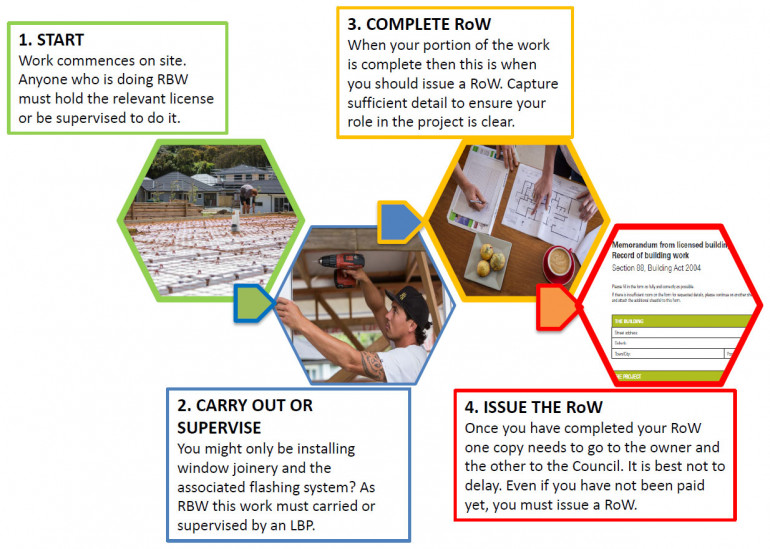Always play by the rules with records of work (RoW)
Codewords 81: November 2017
When completing and issuing records of work (RoWs), licensed building practitioners (LBPs) have certain obligations.

The Building Practitioners Board (the Board) continues to receive a high number of complaints about LBPs not issuing RoWs when they are required. Not providing a RoW is a poor reason to come before the Board so please ensure your records are up to date.
You can read more information on how RoWs should be used in a previousCodewords article: Know your stuff: For the record.
What are the rules?
Each LBP who carries out or supervises restricted building work (RBW) must, on completion of the RBW, provide a RoW to the home owner and territorial authority (the local council). This requirement is set out in section 88 of the Building Act. It is also a disciplinary matter for LBPs if a RoW is not provided when one is required – meaning that you could be disciplined by the Board.
What is a RoW for?
A RoW is designed to be a documented record of who carried out or supervised RBW under a building consent.
It protects you by listing only what you did, removing future uncertainly in situations where multiple contractors have performed or supervised RBW on one site. For this reason the accuracy of the record is important as it will remain with the building records for the life of the building. It serves as an enduring and accurate record of RBW undertaken on-site.
How does this play out in practice?
When you have completed your portion of RBW on-site you should:
- complete a RoW, either in the LBP portal(external link) or by using another valid method, eg the standard Record of Work (RoW) form(external link).
- ensure the record is sufficiently detailed so it describes each aspect of the RBW you either carried out or supervised (your role could include a combination of supervision and doing work)
- provide a copy of the RoW to both the home owner and to the local council.
What if I don’t provide a RoW?
You could face disciplinary action by the Board if you do not provide a RoW when one is required. You must not withhold a RoW for non-payment of work under a building contract or simply because you are in dispute with the client.
Failure to provide a RoW is a disciplinary matter for which the Board has zero tolerance.
For a more detailed overview of these requirements, refer to the Board’s decision on the LBP website: Complaint No. C2 01170
The RoW process

Steps in the RoW process
- START Work commences on site. Anyone who is doing RBW must hold the relevant license or be supervised to do it.
- CARRY OUT OR SUPERVISE You might only be installing window joinery and the associated flashing system? As RBW this work must carried or supervised by an LBP.
- COMPLETE RoW When your portion of the work is complete then this is when you should issue a RoW. Capture sufficient detail to ensure your role in the project is clear.
- ISSUE THE RoW Once you have completed your RoW one copy needs to go to the owner and the other to the Council. It is best not to delay. Even if you have not been paid yet, you must issue a RoW.
Quiz
1) What is the reason for a Record of Work?
- To make sure the home owner doesn’t do anything they’re not supposed to.
- To record who carried out the restricted landscaping and electrical work on a particular job.
- To record who carried out or supervised restricted building work on a job.
2) Why should you add full details to a record of work?
- The law requires you write at least 150 words to complete it.
- MBIE says you have to.
- It can protect you by listing only what you did, excluding other people’s work.
3) How long after you finish your work should you provide a copy to the home owner and the local council?
- On completion of the RBW.
- By the time the code compliance certificate is applied for.
- Less than one year.
Check answers
1) What is the reason for a Record of Work?
c. To record who carried out or supervised restricted building work on a job.
2) Why should you add full details to a record of work?
c. It can protect you by listing only what you did, excluding other people’s work.
3) How long after you finish your work should you provide a copy to the home owner and the local council?
a. On completion of the RBW.
